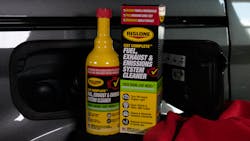Tech Tip: Clearing a check engine light can be as simple as cleaning the system
Having the check engine light (CEL) come on can be stressful. Some folks worry the car will stop running at any moment. Others worry about a repair bill. Fortunately, you can alleviate their fears.
But first, you have to diagnose the issue. Many things can cause a CEL to come on, from a loose gas cap to a bad oxygen sensor. Remember, if your OBD reader pulls one of the codes that indicates a problem with catalytic converter efficiency: P0420, P0421, P0430, or P0431, that doesn’t automatically mean it needs to be replaced.
The code means either the converter is operating below efficiency or below the operating threshold. The CEL and the information gathered from additional diagnostic tools may only identify the faulty engine part but not necessarily the reason for the fault. Sometimes a malfunctioning component is caused by contaminants, soot, carbon build-up, and oily residue affecting a part's function or running performance.
If you or the technician has determined that the problem won’t lead to immediate engine failure, check with the customer on their appetite for fixing the vehicle to determine the next steps. Perhaps they are looking to squeeze a few more miles out of it, and investing in new parts isn’t worth it for them, or maybe their budget is currently limited, and only the most cost-effective solution is required. If so, this is the time to pull the other tool out of your bag and recommend a chemical cleaning product.
Because the CEL can cover any one of several issues, you should use a product that thoroughly cleans all related systems: emissions, fuel and exhaust. A thorough cleaning is often all it takes to clear the code and get your customer back on the road. Cleaning the system can also be a good first step for resolving intermittent issues.
Even if the issue is more severe and does require replacing the oxygen sensor, catalytic converter, or other parts, don’t put the cleaner away just yet. After you install new parts, add a bottle of fuel, exhaust, and emissions system cleaner to scrub the system of contaminants, soot, carbon build-up, and oily residue to restore the performance and protect the new components.
Regularly cleaning the fuel, exhaust, and emissions system every 5,000 miles can keep the engine operating as it should for maximum power, performance, and fuel economy. Consider using a system cleaner during regular oil changes.
Tech Tip brought to you by rislone.com
